Friday, March 20, 2009
Welcome....
....to my site. As you will see my main focus is producing locality specific animals. I'm not much into these man-made morphs, to me the patterns, color schemes and hues that nature has provided these animals to survive in their ecosystem is far more interesting and fascinating than any man made designs, even though some of these morphs are very attractive animals. If you have any questions or comments please drop me a line. Thanks--Scott sjohn10@hotmail.com.
Okeetee Cornsnakes
"On the Okeetee, Cornsnakes are the most numerous snakes and they grow up greater in size and greater beauty than any I have known from elsewhere...the prettiest have a rich orange ground color with vermilion blotches. In my estimation the Cornsnake is not only the most beautiful nonpoisonous snake in the United States, but in the world as a whole."
Snakes and Snake Hunting
--Carl Kaffeld
The late, great Carl Kaffeld said it best concerning these animals. He is the person most responsible for raising awareness about this locality of Cornsnake. My Okeetees are true locality snakes that actually have origins to Jasper Co., S.C. not just some pretty red-orange Cornsnakes, and my stock they has not been "polluted'" by any other outside genes. My original breeders were offspring from wild-caught Cornsnakes that were captured in and around the old Okeetee Plantation by two different sets of friends. I was able to obtain several offspring from these animals, and the ones that grew up to be the most attractive founded my breeding colony. This all began some 20 years ago.
 This an old photo of one of my original F1 breeders that was born in 1987 from those wild caught Okeetees. This animal died in the summer of 2006 and she produced around 400 offspring in her life. This animal had those classic thick black borders around the blotches and never developed the dark longitudinal lines that many Okeetees do.
This an old photo of one of my original F1 breeders that was born in 1987 from those wild caught Okeetees. This animal died in the summer of 2006 and she produced around 400 offspring in her life. This animal had those classic thick black borders around the blotches and never developed the dark longitudinal lines that many Okeetees do.
 This is a F2 animal that has the look typical of many of the nicer Okeetees you may find in the wild. This snake has the nice black borders, and with maturity this snake has developed a hint of those dark longitudinal stripes, as many of the real Okeetees do.
This is a F2 animal that has the look typical of many of the nicer Okeetees you may find in the wild. This snake has the nice black borders, and with maturity this snake has developed a hint of those dark longitudinal stripes, as many of the real Okeetees do.
-med.jpg) This is a F3 animal that is an example of some of the variations you see with this locality. Not all Okeetees have the heavy black borders, some such as this specimen almost have a hypo look to them and have reduced black borders but they seem to have more intense orange-red hues. Whatever look you prefer, this line of Okeetees will give you a representation of what a colorful, wild-type Okeetee is... since these guys are strictly locality specific animals.
This is a F3 animal that is an example of some of the variations you see with this locality. Not all Okeetees have the heavy black borders, some such as this specimen almost have a hypo look to them and have reduced black borders but they seem to have more intense orange-red hues. Whatever look you prefer, this line of Okeetees will give you a representation of what a colorful, wild-type Okeetee is... since these guys are strictly locality specific animals.
Snakes and Snake Hunting
--Carl Kaffeld
The late, great Carl Kaffeld said it best concerning these animals. He is the person most responsible for raising awareness about this locality of Cornsnake. My Okeetees are true locality snakes that actually have origins to Jasper Co., S.C. not just some pretty red-orange Cornsnakes, and my stock they has not been "polluted'" by any other outside genes. My original breeders were offspring from wild-caught Cornsnakes that were captured in and around the old Okeetee Plantation by two different sets of friends. I was able to obtain several offspring from these animals, and the ones that grew up to be the most attractive founded my breeding colony. This all began some 20 years ago.
 This an old photo of one of my original F1 breeders that was born in 1987 from those wild caught Okeetees. This animal died in the summer of 2006 and she produced around 400 offspring in her life. This animal had those classic thick black borders around the blotches and never developed the dark longitudinal lines that many Okeetees do.
This an old photo of one of my original F1 breeders that was born in 1987 from those wild caught Okeetees. This animal died in the summer of 2006 and she produced around 400 offspring in her life. This animal had those classic thick black borders around the blotches and never developed the dark longitudinal lines that many Okeetees do. This is a F2 animal that has the look typical of many of the nicer Okeetees you may find in the wild. This snake has the nice black borders, and with maturity this snake has developed a hint of those dark longitudinal stripes, as many of the real Okeetees do.
This is a F2 animal that has the look typical of many of the nicer Okeetees you may find in the wild. This snake has the nice black borders, and with maturity this snake has developed a hint of those dark longitudinal stripes, as many of the real Okeetees do.-med.jpg) This is a F3 animal that is an example of some of the variations you see with this locality. Not all Okeetees have the heavy black borders, some such as this specimen almost have a hypo look to them and have reduced black borders but they seem to have more intense orange-red hues. Whatever look you prefer, this line of Okeetees will give you a representation of what a colorful, wild-type Okeetee is... since these guys are strictly locality specific animals.
This is a F3 animal that is an example of some of the variations you see with this locality. Not all Okeetees have the heavy black borders, some such as this specimen almost have a hypo look to them and have reduced black borders but they seem to have more intense orange-red hues. Whatever look you prefer, this line of Okeetees will give you a representation of what a colorful, wild-type Okeetee is... since these guys are strictly locality specific animals.
Wednesday, March 18, 2009
Texas Baird's Ratsnakes
One of the most interesting of all the western Ratsnakes are the jewels of Texas .... the Baird's Ratsnake. Their combination of brilliant and subtle hues of colors has caused a huge increase in their popularity lately. Adding to this, is the variations that is seen with different populations throughout Texas. Also, Baird's Ratsnakes are one of the most docile of snakes and the large hatchlings are easy to raise. I first started breeding Baird's Ratsnakes in the early '90's with a Val Verde Co. group and I now have three groups of Baird's from three distinct locality specific populations. I have specimens from the eastern most part of their range, the middle part and the western portion, all distinctly different from each other. In coming seasons I hope to add to the locales I am presently working with.
-med.jpg) Bandera Co. Baird's --This group originates from the far eastern part of their range along the edges of the Edwards Plateau. I have struggled to get a photo that represents the true colors of my breeders. These animals have some of the most extensive and intense orange that you will see in any Baird's.
Bandera Co. Baird's --This group originates from the far eastern part of their range along the edges of the Edwards Plateau. I have struggled to get a photo that represents the true colors of my breeders. These animals have some of the most extensive and intense orange that you will see in any Baird's.
Loma Alta Baird's--This locale is in the middle part of their range in Val Verde Co. which is just north of the Mexican border and east of Big Bend National Park. Animals from this locale are known for their very light, silvery almost metallic ground color which is enhanced by the red-orange highlights. This is one of the most sought after looks for Baird's Ratsnakes.
 This specimen is a good example of the silvery metallic look seen in Baird's of this locale.
This specimen is a good example of the silvery metallic look seen in Baird's of this locale.
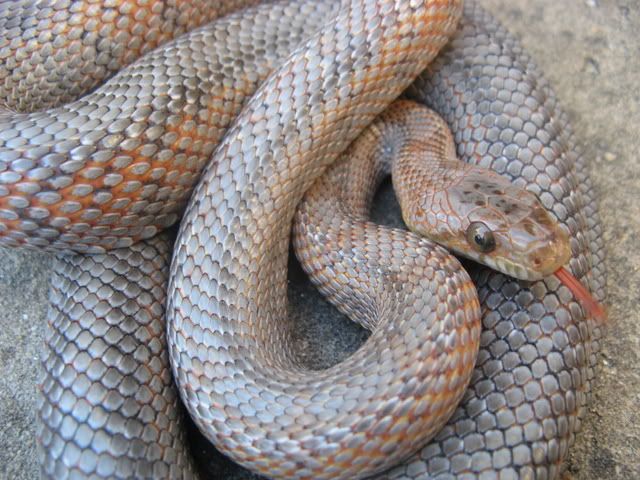 This close-up photo of the same animal shows the red-orange highlights.
This close-up photo of the same animal shows the red-orange highlights.
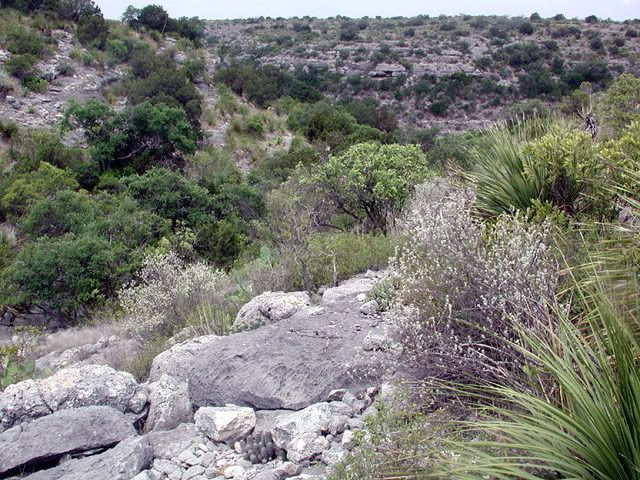 Typical habitat in Val Verde Co. Baird's Ratsnakes are often found in the layers of limestone that characterizes this region. Photo courtesy of Nathan Wells.
Typical habitat in Val Verde Co. Baird's Ratsnakes are often found in the layers of limestone that characterizes this region. Photo courtesy of Nathan Wells.
Davis Mtn--This is a locale from the western part of their range in Jeff Davis Co. Specimens from this region are known to be more brown and darker than animals from other locales. This may be an adaptation for thermal regulation due to the elevation of this area. The bright highlights they can exhibit with the dark ground color makes them among the most striking of Baird's.
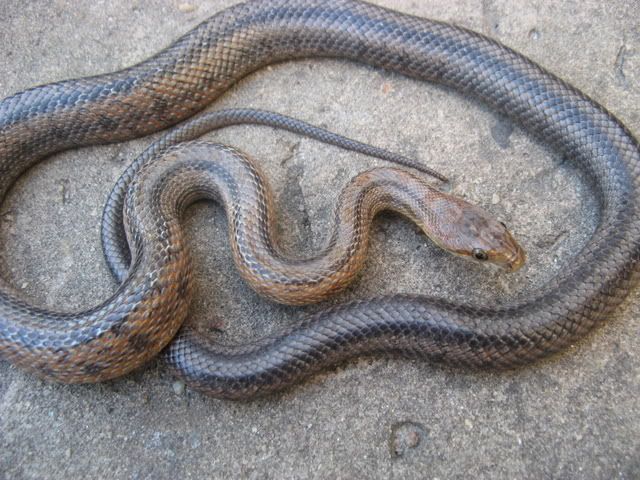
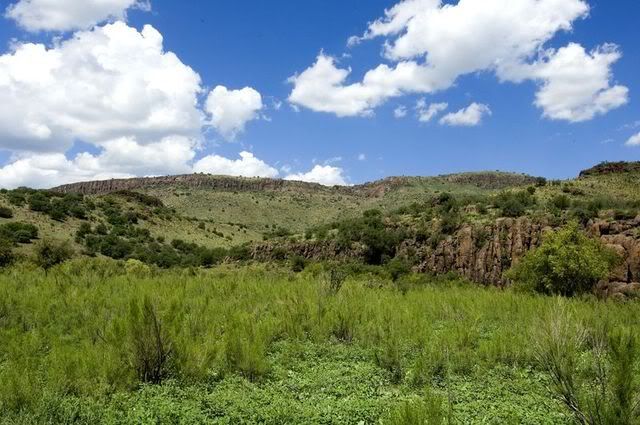 Davis Mountain habitat which is one of the highest elevations where Baird's Ratsnakes are found. Photo courtesy of Jack Goldfard
Davis Mountain habitat which is one of the highest elevations where Baird's Ratsnakes are found. Photo courtesy of Jack Goldfard
-med.jpg) Bandera Co. Baird's --This group originates from the far eastern part of their range along the edges of the Edwards Plateau. I have struggled to get a photo that represents the true colors of my breeders. These animals have some of the most extensive and intense orange that you will see in any Baird's.
Bandera Co. Baird's --This group originates from the far eastern part of their range along the edges of the Edwards Plateau. I have struggled to get a photo that represents the true colors of my breeders. These animals have some of the most extensive and intense orange that you will see in any Baird's.Loma Alta Baird's--This locale is in the middle part of their range in Val Verde Co. which is just north of the Mexican border and east of Big Bend National Park. Animals from this locale are known for their very light, silvery almost metallic ground color which is enhanced by the red-orange highlights. This is one of the most sought after looks for Baird's Ratsnakes.
 This specimen is a good example of the silvery metallic look seen in Baird's of this locale.
This specimen is a good example of the silvery metallic look seen in Baird's of this locale. This close-up photo of the same animal shows the red-orange highlights.
This close-up photo of the same animal shows the red-orange highlights. Typical habitat in Val Verde Co. Baird's Ratsnakes are often found in the layers of limestone that characterizes this region. Photo courtesy of Nathan Wells.
Typical habitat in Val Verde Co. Baird's Ratsnakes are often found in the layers of limestone that characterizes this region. Photo courtesy of Nathan Wells.Davis Mtn--This is a locale from the western part of their range in Jeff Davis Co. Specimens from this region are known to be more brown and darker than animals from other locales. This may be an adaptation for thermal regulation due to the elevation of this area. The bright highlights they can exhibit with the dark ground color makes them among the most striking of Baird's.

 Davis Mountain habitat which is one of the highest elevations where Baird's Ratsnakes are found. Photo courtesy of Jack Goldfard
Davis Mountain habitat which is one of the highest elevations where Baird's Ratsnakes are found. Photo courtesy of Jack Goldfard
Monday, March 16, 2009
Mexican Baird's Ratsnake
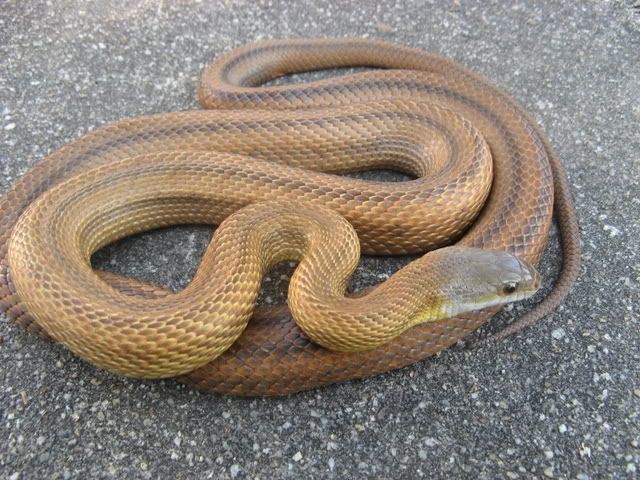 Nuevo Leon locale Baird's are truly different from the Texas populations. In fact, many herpetologist are under the opinion they probably should be classified differently from the Texas populations. Even though the young start out looking like any other Baird's, as adults, they have a stunning combination of colors. Their body may have rich orange hues or bright yellows like the one above. They all have these interesting slate grey heads with the white lower jaw. Locality specimens, such as these, are uncommon in collections.
Nuevo Leon locale Baird's are truly different from the Texas populations. In fact, many herpetologist are under the opinion they probably should be classified differently from the Texas populations. Even though the young start out looking like any other Baird's, as adults, they have a stunning combination of colors. Their body may have rich orange hues or bright yellows like the one above. They all have these interesting slate grey heads with the white lower jaw. Locality specimens, such as these, are uncommon in collections.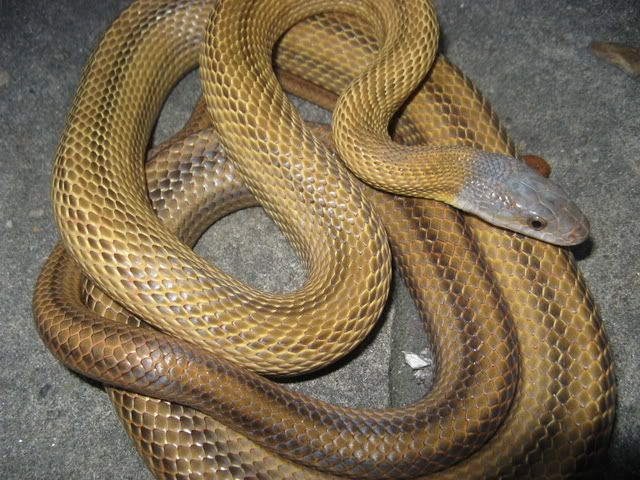 This is a nice example of an individual that is more yellow in color.
This is a nice example of an individual that is more yellow in color.
Colorado Spotted Ratsnake

-med.jpg) This is a favorite western Ratsnake of mine that is an uncommonly offered form of Great Plains Ratsnake which are found in an isolated population bordering Colorado and Utah. My specimens originate from Delta Co. Colorado. Like many animals from an isolated area, they are different from other guttata, in fact Klaus-Deter Schulz descibes them as being very different from other guttata and suggests that the intermontana nominclature should be retained. Adults are not as big as other emoryi that are found nearby, clutch size is smaller however hatchlings are robust and are great feeders on mice from the start. Adults develop these interesting greenish blotches that are really not noticeable in the above photo.
This is a favorite western Ratsnake of mine that is an uncommonly offered form of Great Plains Ratsnake which are found in an isolated population bordering Colorado and Utah. My specimens originate from Delta Co. Colorado. Like many animals from an isolated area, they are different from other guttata, in fact Klaus-Deter Schulz descibes them as being very different from other guttata and suggests that the intermontana nominclature should be retained. Adults are not as big as other emoryi that are found nearby, clutch size is smaller however hatchlings are robust and are great feeders on mice from the start. Adults develop these interesting greenish blotches that are really not noticeable in the above photo.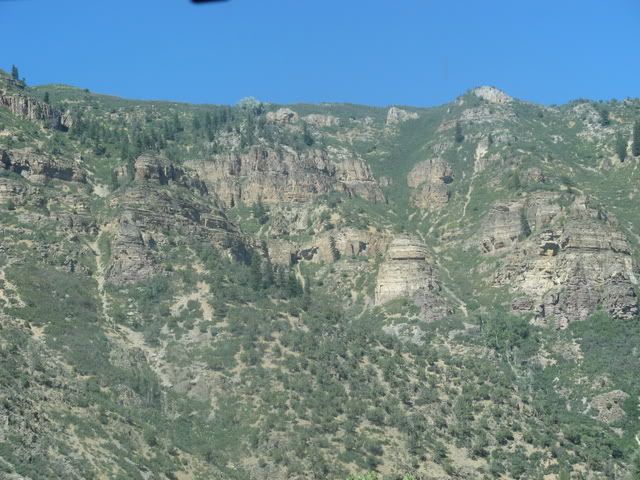 Habitat photo taken from one of the valleys carved by the Colorado River where this species is found.
Habitat photo taken from one of the valleys carved by the Colorado River where this species is found.Friday, March 13, 2009
Western Green Ratsnake
This interesting Ratsnake in the U.S is found in only a few isolated areas in S.E. Arizona. My animals are from the beautiful Santa Rita Mountains. This species has been highly coveted by Ratsnake keepers for a long time. It was once thought they were difficult to keep in captivity but captive born anaimls are in fact rather easy to keep if youy pay attention to a few details. They do best when kept with a moist hide along with a dry one and need a warm spot during brumation. They are great feeders, not prone to regurge problems like some other Western Ratsnakes. As with many keepers of Green Ratsnakes, they are one of the prize jewels of my collection.
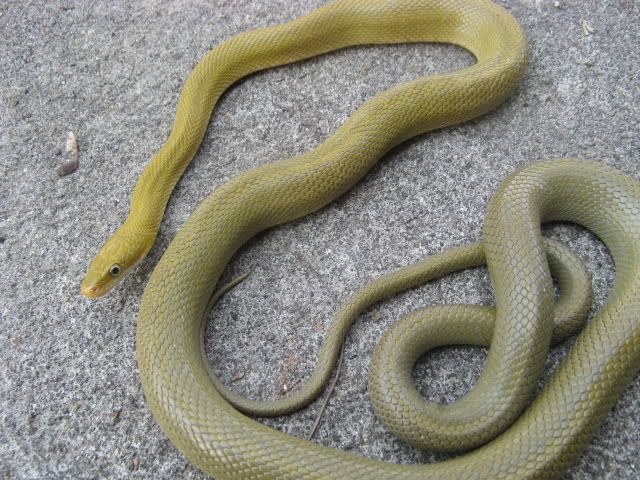 This is one of my breeders, they are rather slow delibrately moving snakes which is unusual compared to many Ratsnakes.
This is one of my breeders, they are rather slow delibrately moving snakes which is unusual compared to many Ratsnakes.
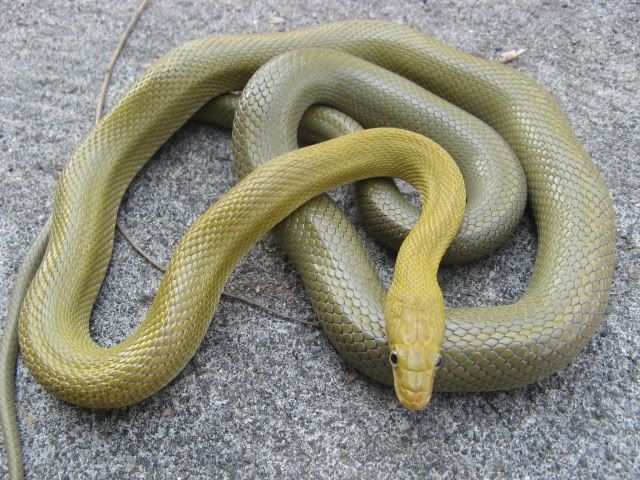 This photo gives you a good look at their long rectangular heads.
This photo gives you a good look at their long rectangular heads.
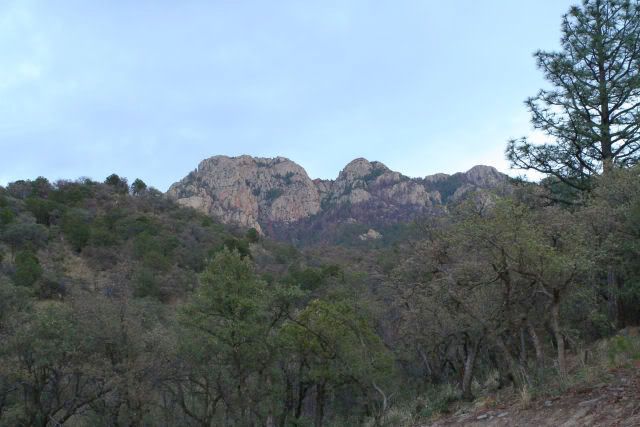 Santa Rita habitat where Green Ratsnakes are often found. These snakes are usually found in riparian areas that support sycamore, oak, walnut, wild grape and cottonwoods. However, they can be found at lower elevations in the semi-desert grasslands.
Santa Rita habitat where Green Ratsnakes are often found. These snakes are usually found in riparian areas that support sycamore, oak, walnut, wild grape and cottonwoods. However, they can be found at lower elevations in the semi-desert grasslands.
 This is one of my breeders, they are rather slow delibrately moving snakes which is unusual compared to many Ratsnakes.
This is one of my breeders, they are rather slow delibrately moving snakes which is unusual compared to many Ratsnakes. This photo gives you a good look at their long rectangular heads.
This photo gives you a good look at their long rectangular heads. Santa Rita habitat where Green Ratsnakes are often found. These snakes are usually found in riparian areas that support sycamore, oak, walnut, wild grape and cottonwoods. However, they can be found at lower elevations in the semi-desert grasslands.
Santa Rita habitat where Green Ratsnakes are often found. These snakes are usually found in riparian areas that support sycamore, oak, walnut, wild grape and cottonwoods. However, they can be found at lower elevations in the semi-desert grasslands.Ladder Ratsnakes
-med.jpg) Ladder snakes are a rather uncommonly kept European Ratsnake of the Iberian Peninsula and southern France. They are medium sized snake, around 4-4.5 ft on average, they remind many of our American Pituophis with their build and ability to hiss. I have breeding groups from the central plateau of Spain and from the Alpes-de-Haute-Provence in southern France.There is not much difference in appearance in animals from these locales. Hatchlings are boldly marked, such as this nice yellow individual from my Spanish group.
Ladder snakes are a rather uncommonly kept European Ratsnake of the Iberian Peninsula and southern France. They are medium sized snake, around 4-4.5 ft on average, they remind many of our American Pituophis with their build and ability to hiss. I have breeding groups from the central plateau of Spain and from the Alpes-de-Haute-Provence in southern France.There is not much difference in appearance in animals from these locales. Hatchlings are boldly marked, such as this nice yellow individual from my Spanish group.-med.jpg) With maturity many develop the striping as seen in this individual.......
With maturity many develop the striping as seen in this individual........jpg) ....while others reatain some of the juvenile blotches. Unlike many of the European Ratsnakes, this species prefers warm and dry conditions. After several years of working with this species I have found that adult captive born Ladder Snakes do become rather docile and are not the aggresisve animal as has been reported even though they are a bit on the nervous side..
....while others reatain some of the juvenile blotches. Unlike many of the European Ratsnakes, this species prefers warm and dry conditions. After several years of working with this species I have found that adult captive born Ladder Snakes do become rather docile and are not the aggresisve animal as has been reported even though they are a bit on the nervous side..Leopard Ratsnake
-med.jpg)
-med.jpg)
Leopard Ratsnakes are perhaps the crown jewel of European Ratsnakes. My breeding group originates from Dalmatia, Croatia. This species was once reported to be difficult to keep, however I have found them to be very easy and straight forward as any N. American Ratsnake. Hatchlings are rather large and take off voraciously on pinkie mice. Clutch size is small, therefore availability will be limited.
Aesculapian Ratsnake
-med.jpg) Aesculapian Ratsnakes are a widespread Euopean Ratsnake that is quite rare in captivity in the U.S. My breeding group is from the eastern shore of the Black Sea along the Kuban River in south western Russia. Like many European snakes, they prefer cooler temperatures and do not tolerate high heat well. However, they are very resilient captives that are easy to care for. Despite their muted colors they have a beauty that is all their own.
Aesculapian Ratsnakes are a widespread Euopean Ratsnake that is quite rare in captivity in the U.S. My breeding group is from the eastern shore of the Black Sea along the Kuban River in south western Russia. Like many European snakes, they prefer cooler temperatures and do not tolerate high heat well. However, they are very resilient captives that are easy to care for. Despite their muted colors they have a beauty that is all their own.Cave Ratsnakes
-med.jpg) After several years of breeding just about all of the subspecies of Beauty Snakes, since the early 90's, I presently only work with Cave Ratsnakes. They are probably the most spectacular of the Beauty Snakes if not one of the most spectacular Ratsnakes of the world. My breeding group consists of some nice light females such as the one pictured below and my main male breeder is a 7ft. beast with a striking orange-yellow neck. This group originates from the Malaysian province of Kadah. Hatchlings are large and are great feeders from the start.
After several years of breeding just about all of the subspecies of Beauty Snakes, since the early 90's, I presently only work with Cave Ratsnakes. They are probably the most spectacular of the Beauty Snakes if not one of the most spectacular Ratsnakes of the world. My breeding group consists of some nice light females such as the one pictured below and my main male breeder is a 7ft. beast with a striking orange-yellow neck. This group originates from the Malaysian province of Kadah. Hatchlings are large and are great feeders from the start.
West Texas Pituophis
 Photo courtesy of Nathan Wells
Photo courtesy of Nathan WellsIn west Texas from Hudspeth Co. to Terrell Co. lies a large zone of intergradation between the Sonoran Gopher Snake and Bullsnakes. Some ofthe snakes in this region key out as Sonoran Gophers while others as Bullsnakes and many have intermediate characteristics of both. This topic has been discussed and debated for a long time. Range maps depicting the zone of intergradation have changed and been discussed by several people that have studied this issue. Apparently the intermixing of Sonoran Gophers and Bullsnakes corresponds to the expansion and contraction of the Chihuahuan Desert over time which makes for a complex situation between these two subspecies that is difficult to diagnose. However, whatever you call the Pituophis from this region, and as with many zones of intergradation, this region produces some fascinating animals that are unique. In the species accounts below, I have some west Texas Pituophis that are good representatives of what I have just mentioned, interestingly beautiful anaimls that are a product of the equally interesting and beautiful habitat from which they occur.
Friday, March 06, 2009
Christmas Mountain Bullsnake/Gopher Snake
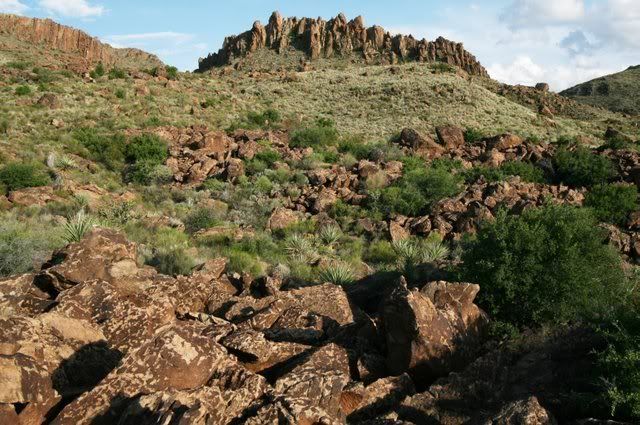 Photo courtesy of Robert Edwards
Photo courtesy of Robert EdwardsIn Brewster Co. lying adjacent to a northern boundary of Big Bend National Park are the rugged and spectacular Christmas Mountains. This locale has been a favorite of Graybanded Kingsnake enthusiasts for a long time. However, they are not the only amazing looking snakes from this locale. This area is known for some of the most beautiful Pituophis in the U.S. Many of the specimens from this area do key out as Sonoran Gopher Snakes, even though this region is many miles to the east of where the Sonoran Gopher range is supposed to end. Whatever they are, this population offers many spectacular animals. Many individulas exhibit a reduced black or hypo look with some nice yellows such as the specimen below.
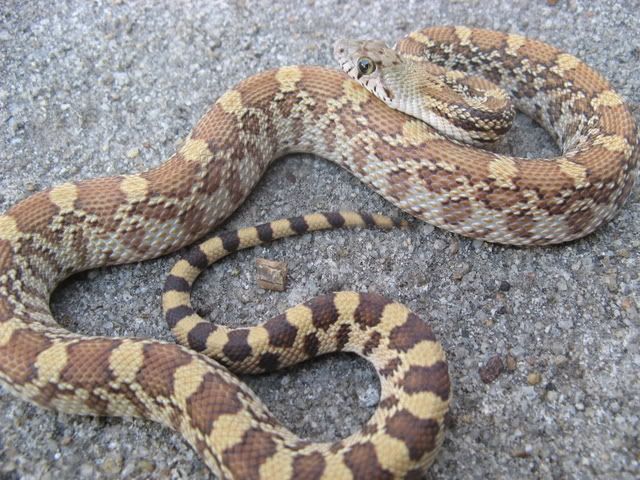
Other individuals will have these interesting purple blotches. I have several bloodlines that will produce a wide array of animals which orginated from a guy that collected several specimens from this area over a number of years. Some of the best looking and unusual ones were the founders of this line.
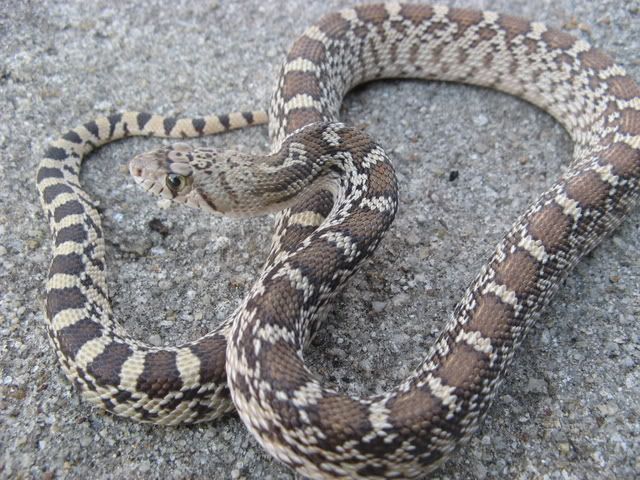
Wednesday, March 04, 2009
Cuesta Del Burro Mtn. Bullsnake/Gopher Snake
In western Presidio Co. Texas lie the very remote Cuesta Del Burro Mountains that are characterized by high elevation grasses, cacti and rocky outcroppings. Since access to this region is limited, these locality Pituophis are uncommon in collections. My breeding group originates from the northwestern foothills of this range. This unique population is one of the most variable in the U.S., patterns and color can vary a lot among indidviduals. Hatchlings may start out rather drab but eventually become stunning adults.
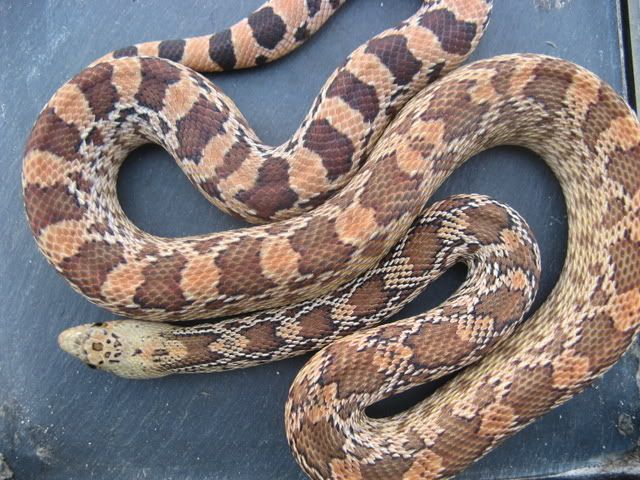 This female has a rather busy pattern, which is common in many individuals from this locale. This particular specimen has a nice red overwash, but I really like the lime green head, which is difficult to capture with a photo.
This female has a rather busy pattern, which is common in many individuals from this locale. This particular specimen has a nice red overwash, but I really like the lime green head, which is difficult to capture with a photo.
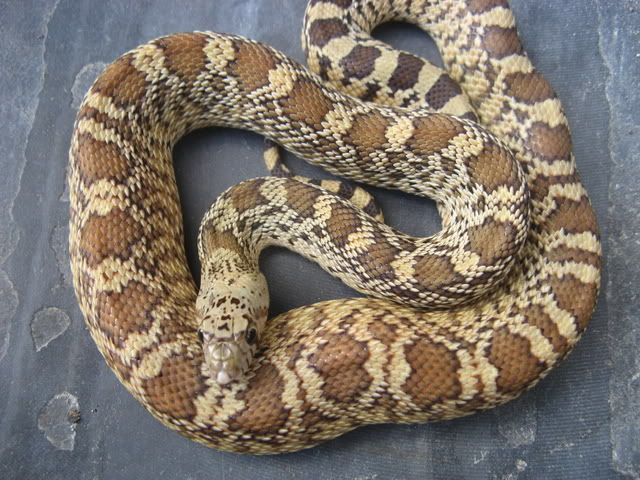 Here is a male that has an interesting yellowish green overwash. Note how different from the specimen above.
Here is a male that has an interesting yellowish green overwash. Note how different from the specimen above.
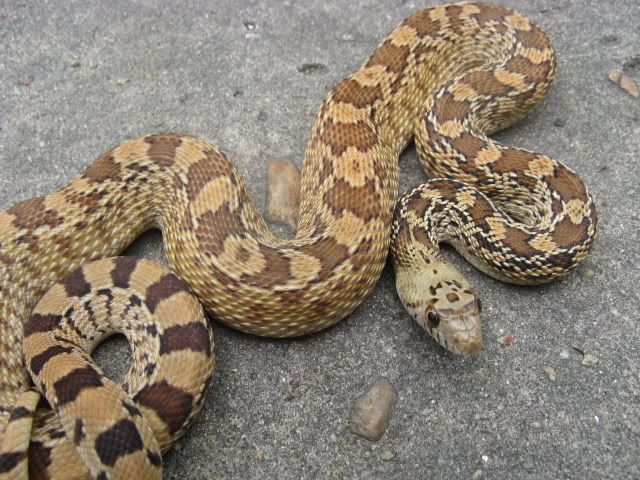 Here is another female that is developing a nice busy pattern laterally.
Here is another female that is developing a nice busy pattern laterally.
 This is an attempt to capture the lime green heads of these snakes.
This is an attempt to capture the lime green heads of these snakes.
 This female has a rather busy pattern, which is common in many individuals from this locale. This particular specimen has a nice red overwash, but I really like the lime green head, which is difficult to capture with a photo.
This female has a rather busy pattern, which is common in many individuals from this locale. This particular specimen has a nice red overwash, but I really like the lime green head, which is difficult to capture with a photo. Here is a male that has an interesting yellowish green overwash. Note how different from the specimen above.
Here is a male that has an interesting yellowish green overwash. Note how different from the specimen above. Here is another female that is developing a nice busy pattern laterally.
Here is another female that is developing a nice busy pattern laterally. This is an attempt to capture the lime green heads of these snakes.
This is an attempt to capture the lime green heads of these snakes.Inyo Co. Great Basin Gopher Snakes

Great Basin Gopher Snakes are a modest sized Pituophis that have temperaments similar to that of a Cornsnake. These snakes are one of the most variable Gopher Snakes across their range. However, some of the most colorful come from eastern California. The group that I have comes from the beautiful high desert in the shadow of the Sierra Nevada Mountains just outside the town of Bishop in Inyo Co. Individuals from this population have a clean yellowish ground color with reddish mid-body blotches. My animals are still young but I hope to produce these in the near future.
 Typical Inyo Co. habitat for Great Basin Gopher Snakes
Typical Inyo Co. habitat for Great Basin Gopher Snakes
Monday, March 02, 2009
Mexican-Lined Gopher Snakes
Mexican-Lined Pines have been a long sought after species for Pituophis fans for many years. I was able to obtain some of the first ones made available. This species is very impressive in size, the original breeders are around 8 ft. in length, and their lemon yellow background colors make them a sight to behold. This species lives in the highlands of southern Mexico where yearly temperatures are mild to cool. The original breeders are now in a zoo and are not being bred, therefore offspring of this species will be somewhat limited. Unlike some of the other montane Mexican Pituophis, hatchling lineaticollis are very hardy and do well with multiple feedings each week.
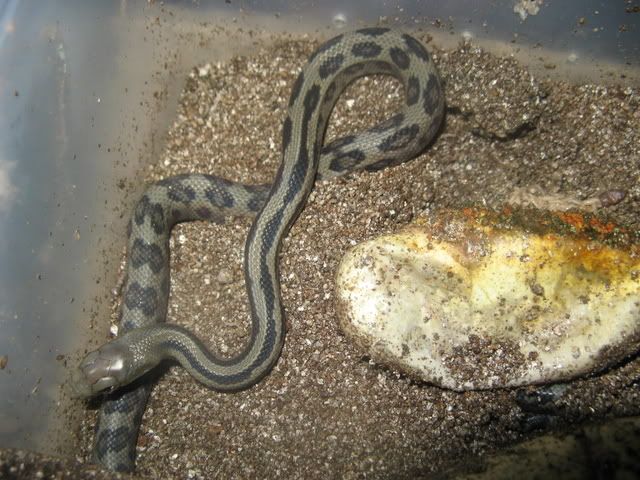 Hatchlings start out looking rather drab but will turn into spectacular adults and as mentioned before, hatchlings are very hardy.
Hatchlings start out looking rather drab but will turn into spectacular adults and as mentioned before, hatchlings are very hardy.
 Hatchlings start out looking rather drab but will turn into spectacular adults and as mentioned before, hatchlings are very hardy.
Hatchlings start out looking rather drab but will turn into spectacular adults and as mentioned before, hatchlings are very hardy.
El Rosario Gopher Snakes
Found in and around the oasis of the El Rosario area of Baja California Norte is a population of Gopher Snakes that is unique to the area and relativley new to herpetoculture. Like the West Texas area, this is a region where the ranges of two species meet, the San Diego Gopher Snake and the Bimaris form of the Cape Gopher. Also, the range of Sonoran Gophers ends close by. According to the literature, San Diego Gophers and Cape Gophers exsist side by side starting in this region and extending down the penninsula for about 100 mi. without intergrading like the West Texas Pituophis do. However, it is apparent that this population has some characteristics of each form, and as with a lot of intergrades, this makes for some really interesting animals. Individuals of this locale have a nice red-orange ground color on the posterior regions of their body unlike the vertebralis populations of the Cape which have the red-orange on the anterior of the body. Snakes from the surrounding area look nothing like these. The founders were collected by two guys from California in the late 90's and I was able to get my breeding group from one the guys that still is working with this locale. Below are some photos of various animals that illustrate the variety found in this population. 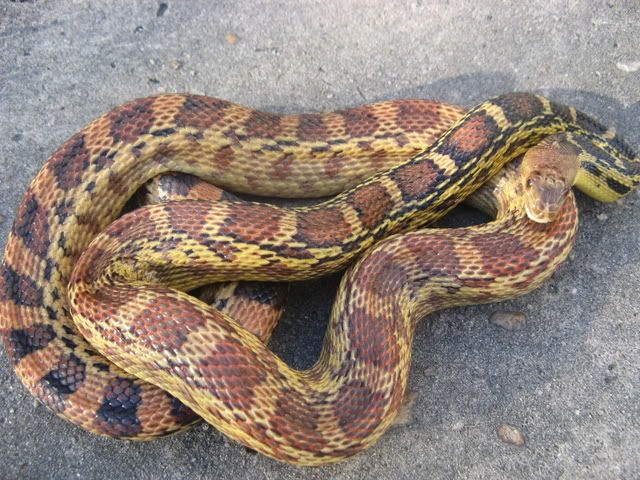
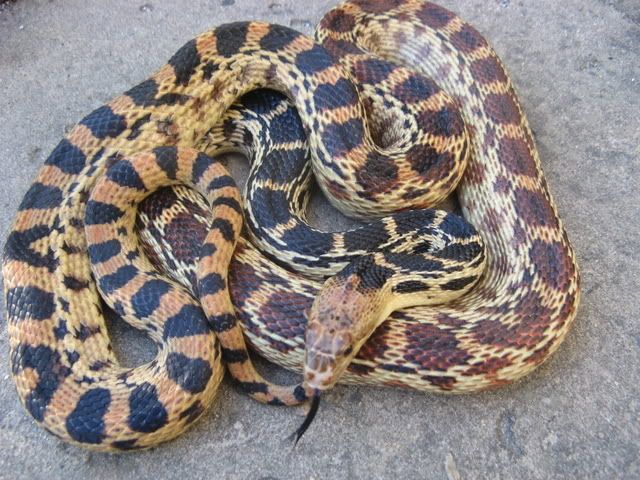 The two photos above are a couple of my female breeders. Like with Cape Gophers, females have the ability to double clutch.
The two photos above are a couple of my female breeders. Like with Cape Gophers, females have the ability to double clutch.
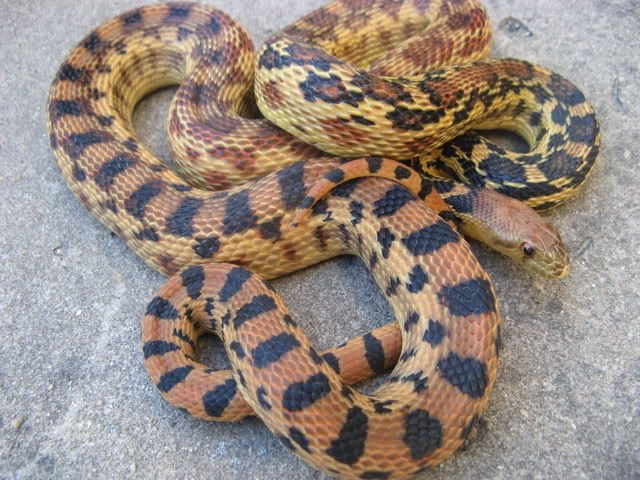 This young male has a nice red-orange tail. However, with some individuals the red-orange can be very intense. Hopefully, I can produce some of these.
This young male has a nice red-orange tail. However, with some individuals the red-orange can be very intense. Hopefully, I can produce some of these.
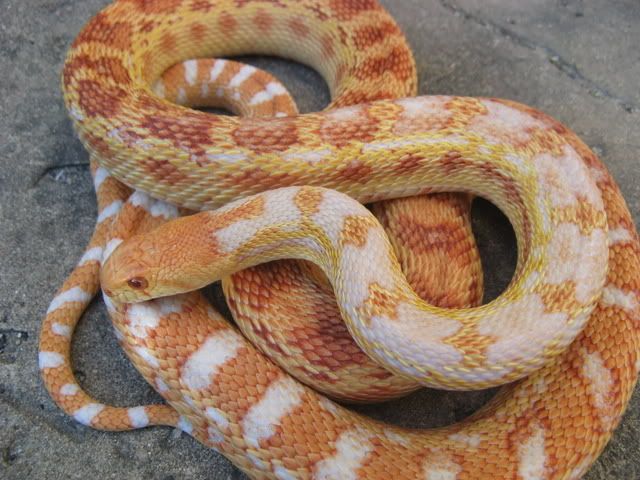 After working and breeding these snakes for awhile it was realized that there was an albino gene in this population when a dead in the egg albino was produced. Soon live albinos were produced and they are truly incredible looking snakes. I'm not much of a morph guy but since this morph is from pure locality animals that makes it different from some of these made-made creations.
After working and breeding these snakes for awhile it was realized that there was an albino gene in this population when a dead in the egg albino was produced. Soon live albinos were produced and they are truly incredible looking snakes. I'm not much of a morph guy but since this morph is from pure locality animals that makes it different from some of these made-made creations.

 The two photos above are a couple of my female breeders. Like with Cape Gophers, females have the ability to double clutch.
The two photos above are a couple of my female breeders. Like with Cape Gophers, females have the ability to double clutch. This young male has a nice red-orange tail. However, with some individuals the red-orange can be very intense. Hopefully, I can produce some of these.
This young male has a nice red-orange tail. However, with some individuals the red-orange can be very intense. Hopefully, I can produce some of these. After working and breeding these snakes for awhile it was realized that there was an albino gene in this population when a dead in the egg albino was produced. Soon live albinos were produced and they are truly incredible looking snakes. I'm not much of a morph guy but since this morph is from pure locality animals that makes it different from some of these made-made creations.
After working and breeding these snakes for awhile it was realized that there was an albino gene in this population when a dead in the egg albino was produced. Soon live albinos were produced and they are truly incredible looking snakes. I'm not much of a morph guy but since this morph is from pure locality animals that makes it different from some of these made-made creations.Louisiana Pinesnakes
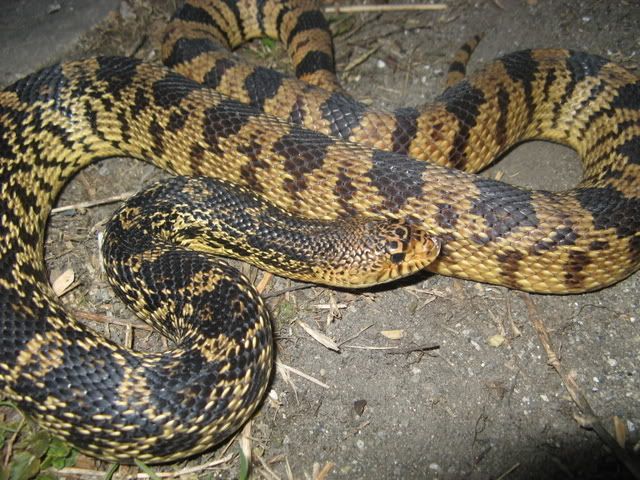 Louisiana Pines are one of the rarest snakes found in North America. Their relatively small range is found along the Louisiana/Texas border in the upland longleaf pine forests. Unfortunately there has been some ruthveni that are of questionable origins. My animals are from the well known Vandeventer line that originates from Bienville Parish in Louisiana. Louisiana Pines can be quite variable in color and pattern, my group is from a line that is known for having a nice yellow ground color. Hatchlings are among the largest from any North American snake and are ready to take on the world.
Louisiana Pines are one of the rarest snakes found in North America. Their relatively small range is found along the Louisiana/Texas border in the upland longleaf pine forests. Unfortunately there has been some ruthveni that are of questionable origins. My animals are from the well known Vandeventer line that originates from Bienville Parish in Louisiana. Louisiana Pines can be quite variable in color and pattern, my group is from a line that is known for having a nice yellow ground color. Hatchlings are among the largest from any North American snake and are ready to take on the world.
Stillwater x Crumbly Red Bullsnakes
These are the only non-locality animals I'm working with. I'm really not into all of the man-made morphs but, this cross produces such interesting offspring, it was a project I had to get into. I have a nice red Crumbly red female, see photo below, that is crossed with my very light hypo Stillwater Bullsnake. Offspring area a pretty yellow, but when they are crossed they will produce a brillant red hypo snake that are much sought after. I'm still a generation from producing these.
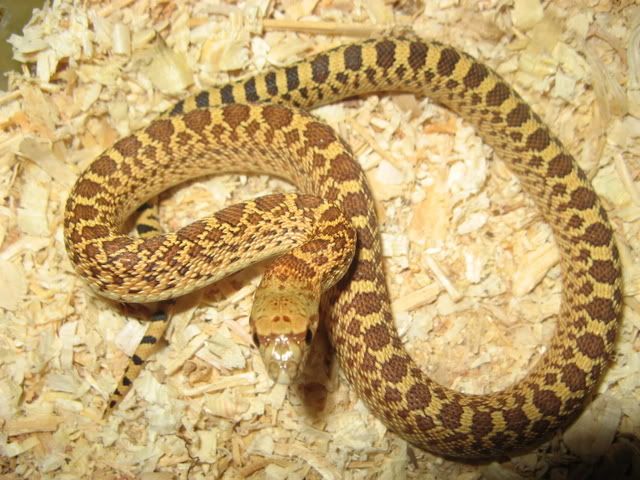 Above is one of the offspring from the Stillwater Red Crumbly cross.
Above is one of the offspring from the Stillwater Red Crumbly cross.
-med.jpg) Stllwater male
Stllwater male
 Above is one of the offspring from the Stillwater Red Crumbly cross.
Above is one of the offspring from the Stillwater Red Crumbly cross.-med.jpg) Stllwater male
Stllwater male
Subscribe to:
Posts (Atom)
-med.jpg)
-med.jpg)